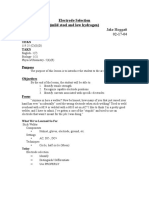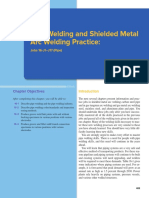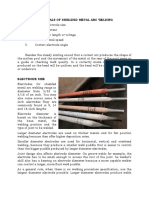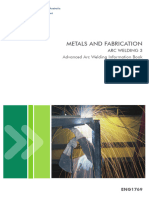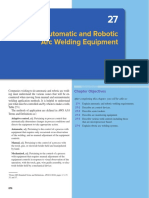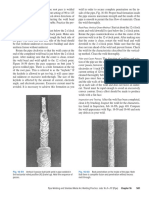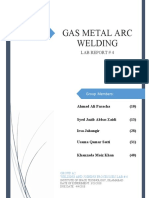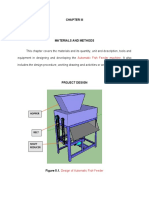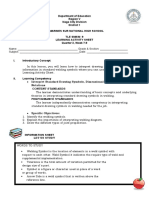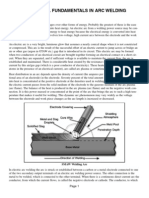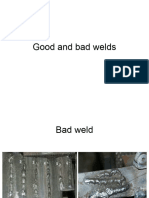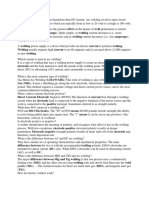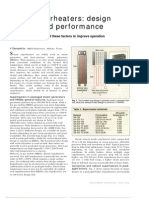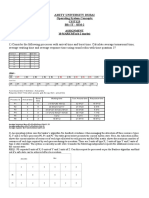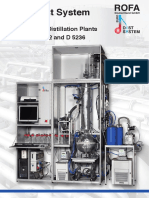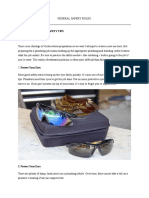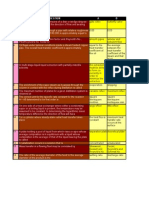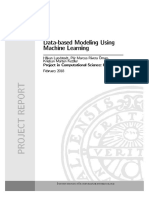Arc Welding Notes
TERMS:
Amperage
The measure of electricity that is flowing between the rod and the metal.
A high amp (amperage) setting will give an agitated puddle
A low amp setting will not spread out and tie in - results in shallow penetration.
Arc Force
This is the pressure at the end of the rod which is created by the electrical arc.
The angle of the electrode (rod angle) controls the arc force.
Arc Gap
The height of the electrode tip off of the metal.
A small arc gap will not allow the metal to heat up, and will give a shallow
penetrating weld.
The first step to controlling the molten puddle is the Arc Gap.
AC
Alternating Current. The electricity flows one way, then switches and goes the
other.
DC
Direct Current. The electricity flows one direction only.
Lead
The cable that runs from the welder to the electrode holder and ground clamp.
Penetration
§ The depth of the weld into the metal. Measured from the surface of
the metal to depth the weld reaches into that metal.
Porosity
§ Caused by welding on metal that is painted, rusted, or has oil or
grease on it.
Rod Angle
A more perpendicular angle will cause the arc force to penetrate the metal deeply,
and leaves a flatter weld bead.
An electrode angle of 45 degrees will cause the arc force to give a bigger weld
build up (taller weld bead) and also will be shallower penetrating.
Speed
§ Too fast of a travel speed will cause a shallow penetrating weld.
§ Too slow causes the puddle to spread out, and you loose control of the
weld.
Undercut
A groove that is created from welding that is below the surface of the metal.
It is created from:
traveling too fast, and/or
improper rod angle, and/or
improper arc gap, and/or
improper amperage of welder.
Weld Joints
T-Fillet, Lap, Corner, Butt (most common weld joints).
Welder
� The machine the welds.
Weldor
The person who is welding.
Penetration
§ The depth of the weld into the metal. Measured from the surface of
the metal to depth the weld reaches into that metal.
WELD POSITIONS
Flat, horizontal, overhead, and vertical.
Vertical Down:
Less penetration
Requires a higher amp setting
Use circular, zigzag, or whip and pause oscillation movement of rod.
Do not use 7018 for Vertical Up welds.
Vertical Up:
Undercutting is usually a problem.
7018 is a good rod for Vertical Up welds. Use a straight of side to side movement
for 7018.
Be cautious of overheating base metal. This is the #1 reason the weld puddle will
fall out.
Horizontal:
Use a circular motion, or a lower case cursive “s.”
Angle the rod (in relation to direction of travel slightly back into the puddle).
Almost perpendicular.
Learning with a thinner electrode (5/32) can be easier.
A faster traveling speed helps keep the weld cool which helps prevent dripping
and/or sagging.
No oscillation (movement of the rod).
Overhead:
Keep the angle of the rod almost perpendicular.
Use a straight or circular motion when oscillating.
Watch out for dripping metal and sparks, a serious burning hazard.
6010 & 6011 will not give a smooth weld bead.
The Meaning of the Electrode Numbers:
If there is an “E” in front of the electrode numbers, it simply means “electrode for
arc welding.”
The first two numbers (i.e. 60 in 6010) represent 60,000 pounds of tensile
strength per square inch.
The third number (i.e. 1 in 6010) represent position, 6010 is an ALL POSITION
rod.
The third and fourth numbers (i.e. 10 in 6010) represent the flux coating.
Stabilizers in the flux is what maintains the arc current.
The last number on the electrode (i.e. 8 in 7018) allows the weldor to know
what type of electrical current the electrode utilizes, such as AC, DC+,
and/or DC-. See chart next page.
� DIRECTIONS FOR USING THE ELECTRODE CURRENT CHART
The following chart will tell the weldor what type of electricity each electrode
requires. The last number of the electrode (i.e. 8 in 7018) is what we are looking at.
The 7018 electrode, for example, means that the electrode is a DC+ electrode.
What this means is that the electrode can weld with the welder leads connected to
either the Alternating Current (AC) connection points, or Direct Current (DC)
connections point.
When connecting the electrode leads AC, it doesn’t matter which lead goes to which
connection point. When connecting to the leads to DC it is very important which lead
goes to which connector. The connection points are labeled + (positive) and –
(negative).
If the lead which has the electrode holder on it is connected to the + (positive)
connection point on the welder, then you will be welding Electrode Positive, which is
called Reverse Polarity ( DC+ = Reverse Polarity). If the electrode holder lead is
connected to the – (negative) connection point on the welder, you will be welding
Electrode Negative, which is called Straight Polarity ( DC- = Straight Polarity).
The “E” on the chart means Either RP (Reverse Polarity) or SP (Straight Polarity).
0 – DC+ only – Reverse Polarity
1 – AC or DC+ (Reverse Polarity – the electrode holder lead connects to the DC +
terminal)
2 – AC or DC- (Straight Polarity - the electrode holder lead connects to the DC -
terminal)
3 – AC or DC+ or DC- the electrode holder lead can connects to the DC + or –
terminal)
4 – AC or DC+ or DC- the electrode holder lead can connects to the DC + or –
terminal)
5 - 0 – DC+ only – Reverse Polarity
6 – AC or DC+ (Reverse Polarity – the electrode holder lead connects to the DC +
terminal)
7 - AC or DC+ (Reverse Polarity – the electrode holder lead connects to the DC +
terminal)
Use this chart for quicker reference:
Electrode Current Chart (note: there is not a 7)
0 DC RP
1 AC/DC RP
2 AC/DC SP
3 AC/DC E (Either RP or SP)
4 AC/DC E (Either RP or SP)
5 DC RP
6 AC/DC RP
8 AC/DC RP
NOTE: All electrodes can utilize a welder set up DC+ except electrodes ending with a
2. Therefore, if a welder can remember that all electrodes can be DC+ except those
ending in “2,” there isn’t much more to remember.
Another point to remember is that electrodes ending in 0 or 5 cannot use AC power,
the whole chart is almost memorized.
Welding Notes in General
�
Two types – DC and AC (DC = Direct Current, AC = Alternating Current)
DCEP = Direct Current, Electrode Positive (See chart last page)
Also, DCEP = DC+
Electrode Positive (E.P.) is called Reverse Polarity (R.P.).
This means that the electrical current (Arc) travels from the METAL UP to the
ROD.
Electricity generally travels from the negative to the positive.
DCEN = Direct Current, Electrode Negative (see chart last page)
Also, DCEN = DC-
Electrode Negative (E.N.) is called Straight Polarity (S.P.).
This means that the Arc travels from the ROD DOWN to the METAL.
DC- keeps the rod cooler, and the metal hotter.
Common Rods: 6010, 6011, 6013, 7018, 7024, 11018
Common Rod Sizes: 3/32, 1/8, 5/32
These are just the most common rod diameters.
This diameter is that of the actual metal rod, not the flux.
6010 & 6011
6010 cannot be used on AC. Both can use DC+ .
Both 6010 & 6011 are Fast Freeze Rods, deep penetrating.
They both have a light flux which allows you to see the molten puddle clearly.
The weld is not as attractive, and is usually used as a first pass rod, which is then
covered by another rod, such as 7018.
A circular, zigzag, or whip and pause electrode motion (oscillation) is
recommended.
Whip and Pause isn’t the best looking weld, is difficult to master, but allow the
deepest penetration and is a process recommended to learn.
Whip and Pause digs in, then when it is whipped back fills in the gouge.
Another process is called Long Arc. Long Arc is for thin metal. The thinner the
metal, the faster this goes.
6011 is the easiest rod to use because of the stabilizers in the rod.
Arc Gap (the height of the tip of the rod off of the metal) is extremely important. Do
not use a small Arc Gap. The small Arc Gap will not give the metal enough time to
heat up.
6013
Easiest to use electrode, designed for high speed welding on sheet metal on DC- .
Stabilizer in flux makes it the easiest to use.
7018
Shallower penetrating than 6010 or 6011
This is a low hydrogen rod with iron powder in the flux which prevents the weld
from cracking.
One of the highest quality welding rod, and can handle higher stress.
The metal must be clean (no rust, dirt, oil, etc. on metal).
Iron powder higher metal deposit rate (used as a filler rod)
Has a heavier slag which allows the molten metal to solidify faster will slag is still
molten.
The 7018 electrode is more sensitive to Arc Gap. Use a constant short arc gap
with 7018.
� Requires a higher amperage setting than 6011.
7024
Clean metal, higher amp setting, very pretty looking weld.
11018
For tempered steel.
